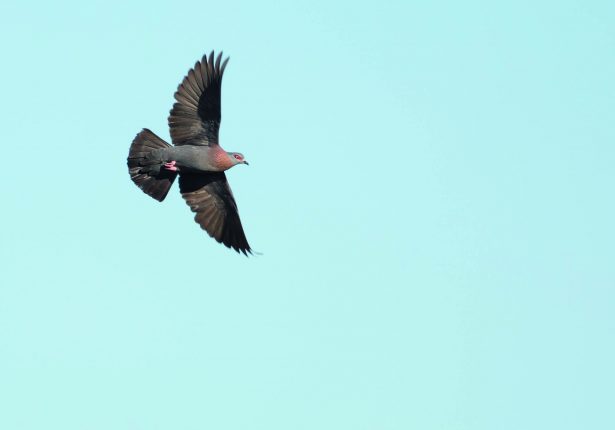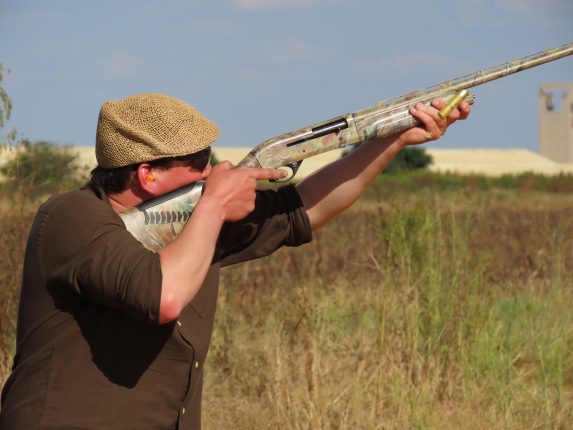Flying all the way to South Africa to shoot pigeon may seem excessive, but there’s a reason the rock pigeon is one of the world’s most attractive species for keen Shots
It might or might not have been an eland. Dusk is short in South Africa, the light was fading and we were barrelling home for cold beers and an Afrikaner supper of warthog and pumpkin fritters. But our host, Joubert Coetzer, said it was. And he knows, having been born and bred on the veld.

Nonetheless, the eland looked a little lost, an extra that had walked on to the wrong film set, for this part of the Free State does not fit the romanticised ideal of Africa of plains game and predators, the ‘big five’ being pursued hotly with camera and binoculars. Such wildlife does abound in the Golden Gate Highlands National Park in the Maluti foothills but here, in the outskirts of Welkom, the land is modern and businesslike. Pylons and power lines march purposefully into the horizon. Heavy freight locomotives exchange klaxon calls. Flawless roads flow with Toyota pickups, including our little convoy on our daily journey past the Rex and Star diamond mines, working kimberlite pipes and Beatrix, with its gold reserves of 1.2 million ounces and 27 million pounds of uranium resources.
Yet despite this pursuit of underground wealth, much of the Free State remains veld, grazed steadily by Bonsmara cattle, a tough South African breed developed in 1957 from crossing Afrikaner cows with Hereford and Shorthorn bulls. And what isn’t devoted to mining and beef is devoted to agriculture. Some 32,000 sq km produce cherries, asparagus, potatoes, peanuts, maize, wheat, soya and sorghum, the scale of which is underlined by grain silos towering like junior skyscrapers over the countryside. But what has brought us out here on a long flight from England are the sunflowers.
The Free State and North West provinces produce some 600,000 to 800,000 tonnes of sunflower seed a year and it is used for producing oil for human consumption and cattle cake. It’s an extremely profitable crop, more so since war has disrupted supplies from the world’s two biggest producers, Ukraine and Russia. And in the Free State, when the crop is ripe, it is attacked daily by pigeon and doves.

ROCK PIGEON SHOOTING IN SOUTH AFRICA
The main species are the speckled pigeon (also known as the rock pigeon) and the red-eyed, Cape turtle and laughing doves. They breed all year round and can inflict such damage to the sunflower crop that they are considered pests, with no close season. And they swarm over the fields in such numbers that a keen pigeon shooter can easily fire 600 to 1,200 shots a day, a rate that’s normally associated with Argentinean dove shooting.
It’s often characterised as ‘volume’ shooting, but the appeal does not lie only in the abundance of quarry. As each species flies at different speeds – and all four will be found attacking the same crop – the Gun has to adjust lead accordingly. They will also fly at different heights, often low at morning flight, when they flight in to feed, and high in the afternoon as they return to roost. The speckled pigeon in particular can be grouse-like before noon, a pheasant doppelgänger after lunch.
And it has other particular qualities that have made it one of the world’s most attractive species for keen Shots: it has a long wing-to-body ratio, giving it a deceptively fast speed; it’s good to eat; and its ability to react to movement is perhaps unmatched by any other quarry species. Couple that with the ease of travel to South Africa – an overnight flight, one hour’s time difference – and the low cost of the sport (we worked it out at around £3 a bird, all in) and it’s easy to understand why many British Guns now have speckled pigeon in their gamebooks.
As with all foreign forays, however, you need the right outfitter. For years, several of my most knowledgeable and experienced shooting friends have stayed with Carel and Carine Coetzer, owners of Grassland Safaris just outside Brandfort in the Free State, about 31/2 hours’ drive from Johannesburg airport. It’s a family affair, run in conjunction with their son Joubert and his wife Diana, and guests are accommodated at their farmhouse, a comfortably old-fashioned house with separate rooms and bathrooms for each guest, unlimited hot water, a full laundry service and an honesty bar. The food is excellent – plenty of springbok and gemsbok together with first-class steaks from their own beef herd and enough salads to ease the conscience.
I first met them a few years ago, the day after my horse had thrown me and damaged my shoulder. Carine patched me up so that I was able to shoot and I’ve never forgotten her kindness. On that trip we shot mixed game, available from 1 May to 31 August, with morning and evening flights for wildfowl (spurwing and Egyptian geese, yellow-billed duck, red-billed teal and white-faced whistling duck) and the days spent walking-up guineafowl, Swainson’s spurfowl, Natal spurfowl, Orange River francolin and common quail.

This time, however, I was out with a party of friends to concentrate entirely on the pigeon and doves, and as usual, Carel was a firm taskmaster. “You know the score, boys,” he announced after dinner on the first night, after we’d seen off a few bottles of excellent Pinotage, “Wheels move at 5.30am and if you’re not in the cars, you’re left behind.” Though much of the gamebird and wildfowl shooting is close to the farm, the main sunflower crops are grown in an area 45 minutes’ drive away, and like every successful pigeon guide, Carel has an extensive network of friendly farmers. This is strengthened by the fact that he’s also a beef farmer and a qualified agricultural adviser with expertise in grazing grasses. It also helps that the farmers really want their crops protected.
Having sped past the gold and diamond mines en route, we trundled past a large flock of guineafowl, noisily affronted by our disturbance, and began lining up, 60 yards apart, with our backs to a belt of scrub trees and a massive earthwork of yellow soil, resembling some rectangular hill fort but actually yet another gold mine waste heap.
There were seven Guns in our team, though the shooting can easily accommodate eight. A slab of 250 cartridges and a seat were dropped off at each ‘peg’ and we waited for the flight to begin. The doves roost in surrounding trees and then fly in to feed, but the speckled pigeon spend their nights atop buildings in local towns. Like London ‘pigeon’ (which are actually descendants of our native, wild rock dove), the speckled pigeon’s natural habitat is rocky outcrops – hence the name ‘rockie’ – but they have evolved rapidly to take advantage of the similar structure and safety offered by rooftops, and will easily travel 25 miles to the nearest foodstuffs.

At around 7am, the shooting started and remained heavy until about 9.30am, by which time everyone had finished their first slab and broken into a second. Felt recoil isn’t a problem if using a semi-automatic, the choice of most of the line, but a couple of us used 12-bore over-and-unders, which easily absorbed most of the kick from the 28g No 71/2 cartridges. It’s wise, though, to wear a recoil pad in your shooting vest.
By 10am the flight was over, so Joubert and his team set up a trestle table and chairs in the shade of a nearby tree, the ground below sprinkled with guineafowl feathers, poured the coffee and began cooking bacon and eggs for brunch while we yakked about the shooting. One of the best Shots in our party was Josef ‘Fefi’ Melcher, a professional shooting coach who has won the FITASC Grand Prix of Germany, in Suhl in 2016, as well as numerous Austrian titles. “I don’t think you can find better bird shooting,” was his view. “It’s a 10. It’s the variety of shots that’s available, everything from ‘grouse’ to the highest ‘pheasant’. And with the different species, you have to adjust to different flying speeds all the time. And then everything changes the next day with the shifts in the wind. It’s just incredibly challenging and exciting.” Fefi’s views are shared by George Digweed, the multi-world championship winner, who was shooting rockies a few months before us. “In a wind, they are one of the most difficult birds to shoot anywhere in the world,” said Digweed. “Like woodpigeon on speed.”

By 1pm, the birds have fed and start heading back to their roosts, so it’s time to pack up the coffee cups and head back into the shooting line. There’s steady shooting till 4.30pm, then guns are sleeved, empty cartridges collected, the bag gathered and beer bottles opened before heading home to the farmhouse, a hot shower, a gin and tonic, supper and bed.
This was the pattern for the whole trip, with some variations. On two of our days, we were shooting within earshot of a small town and within 20 minutes we had a junior crowd watching the sport but kept out of harm’s way by our guides. One of the team, Beltrán Cotoner, who works for the sporting agency Fernando Saiz Spain, was shooting beautifully, regularly taking right-and-lefts at the highest speckled pigeon. And every time he did so, there would be an eruption of cheering. (Even I got a cheer when I managed a double but probably ironically.)

At the end of the flight, our guides let the crowd through and within minutes the field was alive with children and a few adults hunting for the birds and stuffing them into carrier bags. “Most of the birds will be cooked tonight,” said Joubert, “though a fair few will be plucked, dressed, put in a freezer and eaten later or sold.” And indeed, on the way home, we bumped into a party of people chatting away while they plucked birds by the roadside. If this sounds a little awkward, the ‘rich’ enjoying their sport while the ‘poor’ eat the results, then that’s understandable but it’s as well to remember that before the 1980s it was common to make a present of a brace of pheasants in the feather to people of all backgrounds and it was given and accepted with kindness. And today? Well, now we struggle to persuade Guns to take home oven-readies.
No such qualms exist in the Free State, which is just as well, given how many birds we shot. No one kept an exact tally, but the average cartridge consumption for every Gun was 500 to 750 cartridges a day, with a couple shooting more than 1,000.
If they were gamebirds, we would think that excessive, and so would the South African game department, which dictates a maximum daily bag of 10 head of game or wildfowl. But the rules of engagement differ for pest species attacking valuable food crops, which is why we eat a lot of woodpigeon and South Africans happily tuck into speckleds.
Is it worth, though, travelling all the way to South Africa to shoot pigeon? The answer’s a little more emphatic than ‘yes’ – it’s one of the finest shooting experiences in the world, to be forever remembered.
HOW TO GO PIGEON SHOOTING IN SOUTH AFRICA
Contact Carine Coetzer at Grassland Safaris by telephone on +27 83 300 5433 or by email at info@grassland.co.za
Visit: grassland.co.za
Seasons: pigeon and doves – year round, but main season mid-February to 1 May; game and wildfowl – 1 May to 31 August.




